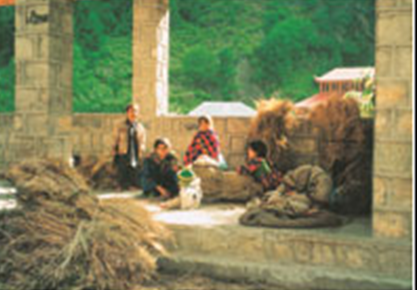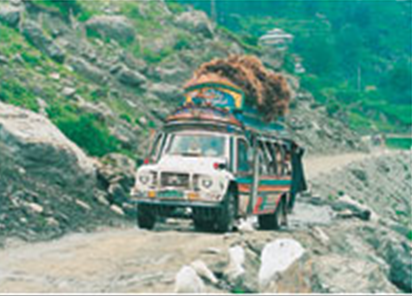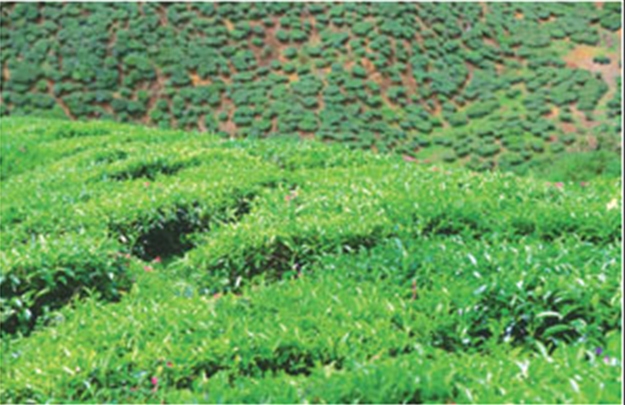Kaghan
This is a collection of articles archived for the excellence of their content. Readers will be able to edit existing articles and post new articles directly |
Kaghan
Passing through Kaghan
By Noor Jehan Mecklai
Trekking through the Kaghan Valley is a fine way to get to know the landscape and the people
YOU remember, of course, how the spider that Scottish King Robert Bruce observed while hiding in a cave, tried seven times to carry its thread of silk across the cave’s entrance before succeeding. However, sometimes one just has to change one’s tactics.
You see, my husband and I were walking with great elan in the Kaghan Valley in happier days, a few years before the earthquake, and the milestone at Chittakatta, about five kilometres from Naran, indicated that we were just 16 kilometres from the village called Kaghan.
So on we strode jauntily downhill towards it, admiring the river all the way. But mysteriously, whenever we asked the distance to Kaghan, it seemed further away. Only one young boy refused us information, throwing a stone at us instead, and shouting, “Jaci badmaash, goral”. Somehow my husband always suffers the gross indignity of being called a foreigner when out with me in the northern areas. Anyway, several kilometres from Kaghan we flagged down a very badly sprung jeep, eventually reaching our destination in this.
Two years later, we again had to cross the finish line somewhat ignominiously, this time balancing on the back of a pick-up truck, and laughing fit to kill, while desperately holding a wildly flapping plastic sheet over ourselves against the huge raindrops that threatened to dissolve us into a nothingness certainly not born of meditation! Furthermore, getting back to Naran in those days was no laughing matter, since all vehicles passing through were stuffed full of humankind and its accoutrements.
Another holiday found us in Khanian, about halfway between Shogran and Naran, having been forced to abandon our Shogran idyll by the advent of a large party from a drug manufacturing corporation. Hmph! So much for democracy and respect. But the hotel was situated tastefully against a backdrop of pines and a foreground of rushing river, with the promise of new nooks and crannies to explore in the neighbouring villages.
And we were now only six kilometres from the pot of gold at the end of the rainbow — from Kaghan. Since “hope springs eternal in the human breast”, we hit the road on foot again, passing firstly a rough bus shelter where a tribal family were packing up to continue trudging all the way back from Balakot, Abbottabad or wherever, to their eyrie further up the valley. They were doing it the hard way, but further along we were passed by more of these folk, crammed into the odd pick-up truck or jeep, along with most of their household goods, and maybe even with an exhausted cow, goat or sheep, or a dog that eyed us lazily. And well he might, as his owner had probably decided in love and charity to give him a lift after miles and miles of padding the hoof. Less fortunate was the handsome young man carrying a huge sack of atta on his shoulders. How far who could guess?
Then what a delight it was to gawp at those jerry-built village houses, blending so perfectly into their surroundings, with their earthen roofs, their sturdy wooden verandah rails, and their rustic doorposts where the occasional goat was tethered, baa-ing away in splendid isolation, while the householder and his family made the most of their few months back in the home fields.
Gawp and be gawped at. That was the idea. However, the friendly eyes of the locals were undisturbing, unlike the endless stares and silly questions from supposedly more sophisticated urban dwellers. But, “Have a heart,” my higher self told me. “How often do any of them see a white-skinned European in something similar to tribal dress?” Seeing me thus clad, some tribes folk even asked if we spoke their Enko dialect. Others, still far from home, asked us for goli to relieve their fatigue-born headaches, or for biscuits for grandparents or children ready to drop.
We hit Kaghan in good time, heartily welcomed back by villagers used to our summertime advent. Once more we feasted our eyes on the picturesque rusticity, the hustle bustle of the place, jumping out of the way of impatient jeeps and overloaded buses in the narrow thoroughfare. One surprise was a glass-fronted shop, displaying a colourful variety of high-heeled shoes, the large hole in its verandah gaping open ever and anon as if tempting the careless. After a visit to the terribly stinky toilet in the usual decrepit hotel, we ate their dal chawal with relish, washing it down with a soft drink, rather than imbibe their questionable tea, which sporting a couple of dead flies was certainly a brew that would neither cheer nor inebriate.
Finally, we about-faced towards Khanian, clocking up the rest of our 12-kilometre perambulation in the mellow afternoon sun that imparted such a lovely softness to the landscape. Sunset comes early to much of the Kaghan Valley, and resting after our day’s odyssey we heard the Azan, echoing loud and clear through Khanian and the neighbouring villages.
Kaghan valley + tea (flora)
Tea treat
By Mian Anwar Tariq
A few years ago, I discussed with a friend of mine plans to visit the Kaghan valley and the enchanting Lake Saiful Malook. My friend is an employee of the Pakistan Agricultural Research Council. He said, while visiting the valley and the lake, I should also look in on the Tea Research Station, Shinkiari, on the silk route, which is a few kilometres away from Mansehra. I liked the idea. And I’ll tell you why.
According to Pakistani newspapers, in the past few years tea cultivation in Pakistan has been a success story. I used to think, if that is true, why is the cultivation process not taking off the way it should? May be tall claims are made to fool the people and the government.
These days, tea import is on the rise. It is the second largest agricultural commodity being imported after edible oil, costing approximately Rs12 billion per annum. The total tea production the world over is 3.82 million metric tons. China, India, Bangladesh, Sri Lanka and Kenya are the main tea producing countries, while Pakistan imports over 100,000 tons annually. Since I am a retired agricultural scientist, I am deeply interested in the development of the agricultural sector, which is considered the backbone of the country’s economy.
So, cutting a long story short, in June 2000 we hit the road to reach the Kaghan valley and that beautiful lake, Saiful Malook. The weather in Hairpur and Havalian was great, but in Abbottabad it was much more delightful.
Abbottabad is a beautiful city surrounded by towering mountains. The fascinating Shimla hill, covered by glorious pines, is a sight to behold. It is certainly the city of my dreams where I lived for a year when I was a young man, enjoying all four seasons. The city houses many fine educational intuitions like the Ayub Medical College, Burn Hall and the Pakistan Military Academy, Kakul. On the other side is the impressive Allayasi majisd, and there is a hill station nearby called Thandiani. Without having a stopover there we passed through the city. The meandering road to Manshera presented a unique landscape. We stopped at a stunning vantage point to enjoy food. We had our lunch at a roadside hotel under a majestic Banyan tree. It was sumptuous. The breeze was cool, invigorating and quite comforting. After travelling to some distance, we saw some dense bushes on the left side and in a short while we were on the premises of the Tea Research Station, Shinkari.
When I entered a place called the experimental area, I for the first time saw the tea cultivation process. Before that, I used to think that the success of tea cultivation was a false claim. Here I must mention that since 1958, attempts were being made to make the process a successful one, but it was in 1975 that it finally started bearing fruit with Chinese assistance, and when the Pakistan Agricultural Research Council took over the project.
To achieve the goal, a number of Chinese varieties were introduced. The experimental area covered approximately 40 acres, mostly by Qi-men cultivar. Tea germplasm from other countries were too introduced to test their suitability to different regions.
In the past, it had happened that various diseases hit the country because of some flaws in the process. Hence, it is suggested that extra care should be exercised to avoid such mishaps. A proper breeding or hybridisation section may be established to develop and breed cultivars by crossing different genotypes suitable to our conditions. Biotechnology and low doses of irradiation can gainfully be employed as an additional tool to create desirable variations. However, emphasis must be put on conventional breeding and subsequently the selection of desirable material followed by the ruthless rejection of hybrid material. It will ultimately lead to the production of better new varieties. Tea is consumed all over the world. It is liked by the rich and the poor, the young and the old, the villager and the city dweller alike. No breakfast or any social get-together is considered complete without it. Some people are so addicted to it that they don’t feel fresh or ready to do their daily chores or jobs without having their tea. There are people who drink many a cup in just a single day.




